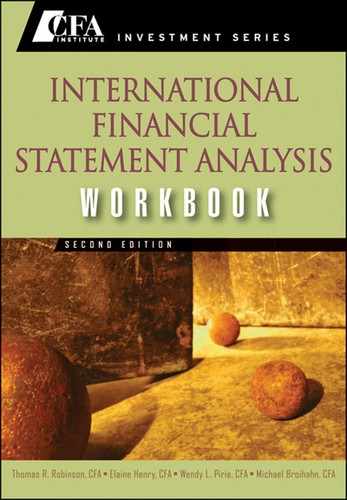CHAPTER 12
NONCURRENT (LONG-TERM) LIABILITIES
1. B is correct. The company receives €1 million in cash from investors at the time the bonds are issued, which is recorded as a financing activity.
2. B is correct. The effective interest rate is greater than the coupon rate and the bonds will be issued at a discount.
3. A is correct. Under U.S. GAAP, expenses incurred when issuing bonds are generally recorded as an asset and amortized to the related expense (legal, etc.) over the life of the bonds. Under IFRS, they are included in the measurement of the liability. The related cash flows are financing activities.
4. B is correct. The bonds will be issued at a discount because the market interest rate is higher than the stated rate. Discounting the future payments to their present value indicates that at the time of issue, the company will record £978,938 as both a liability and a cash inflow from financing activities. Interest expense in 2009 is £58,736 (£978,938 times 6.0 percent). During the year, the company will pay cash of £55,000 related to the interest payment, but interest expense on the income statement will also reflect £3,736 related to amortization of the initial discount (£58,736 interest expense less the £55,000 interest payment). Thus, the value of the liability at 31 December 2010 will reflect the initial value (£978,938) plus the amortized discount (£3,736), for a total of £982,674. The cash outflow of £55,000 may be presented as either an operating or financing activity under IFRS.
5. A is correct. The coupon rate on the bonds is higher than the market rate, which indicates that the bonds will be issued at a premium. Taking the present value of each payment indicates an issue date value of €10,210,618. The interest expense is determined by multiplying the carrying amount at the beginning of the period (€10,210,618) by the market interest rate at the time of issue (6.0 percent) for an interest expense of €612,637. The value after one year will equal the beginning value less the amount of the premium amortized to date, which is the difference between the amount paid (€650,000) and the expense accrued (€612,637) or €37,363. €10,210,618 − €37,363=€10,173,255 or €10.17 million.
6. C is correct. A gain of €3.3 million (carrying amount less amount paid) will be reported on the income statement.
7. A is correct. The value of the liability for zero-coupon bonds increases as the discount is amortized over time. Furthermore, the amortized interest will reduce earnings at an increasing rate over time as the value of the liability increases. Higher relative debt and lower relative equity (through retained earnings) will cause the debt-to-equity ratio to increase as the zero-coupon bonds approach maturity.
8. A is correct. When interest rates rise, bonds decline in value. Thus, the carrying amount of the bonds being carried on the balance sheet is higher than the market value. The company could repurchase the bonds for less than the carrying amount, so the economic liabilities are overestimated. Because the bonds are issued at a fixed rate, there is no effect on interest coverage.
9. C is correct. Covenants protect debt-holders from excessive risk-taking, typically by limiting the issuer’s ability to use cash or by limiting the overall levels of debt relative to income and equity. Issuing additional equity would increase the company’s ability to meet its obligations, so debt-holders would not restrict that ability.
10. B is correct. An operating lease is not recorded on the balance sheet (debt is lower), and lease payments are entirely categorized as rent (interest expense is lower.) Because the rent expense is an operating outflow but principal repayments are financing cash flows, the operating lease will result in lower cash flow from operating activity.
11. B is correct. The lessee will disclose the future obligation by maturity of its operating leases. The future obligations by maturity, leased assets, and lease liabilities will all be shown for finance leases.
12. B is correct. When a lease is classified as an operating lease, the underlying asset remains on the lessor’s balance sheet. The lessor will record a depreciation expense that reduces the asset’s value over time.
13. A is correct. A sales-type lease treats the lease as a sale of the asset, and revenue is recorded at the time of sale equal to the present value of future lease payments. Under a direct financing lease, only interest income is reported as earned. Under an operating lease, revenue from rent is reported when collected.
14. A is correct. A portion of the payments for capital leases, either direct financing or sales-type, is reported as interest income. With an operating lease, all revenue is recorded as rental revenue.
15. C is correct. The current debt-to-total-capital ratio is $840/($840+$520)=0.62. To adjust for the lease commitments, an analyst should add $100 to both the numerator and denominator: $940/($940+$520)=0.64.
16. B is correct. Under both IFRS and U.S. GAAP, a company can choose to report net pension obligation as the pension obligation less the plan assets. Under IFRS, the company also has the option to exclude any cumulative actuarial gains or losses or past service costs from the balance sheet.
